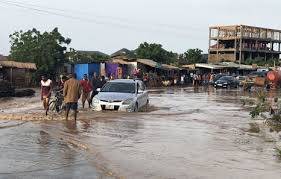Accra’s Flood Control Projects Show Mixed Results After Heavy Rains — Are We Really Making Progress or Just Getting Wet Slower?
A few nights ago, I was jolted awake by the sound of rain pounding on the roof. Not the gentle kind that helps you sleep better, no. This was the kind of rain that makes you jump up and check your windows, your sockets, and then pray the power doesn’t go out. Again.
By morning, parts of Accra were already in the news—flooded. Again. And this time, there was an extra twist: some areas were dry, surprisingly. Like, actually dry. That’s when I remembered the government had been working on a bunch of flood control projects. New drains, improved gutters, channeling systems—the whole works.
So… did it work?
Well, kind of. Some areas like Kaneshie and sections of Adabraka that used to look like Venice after every rain were relatively okay this time around. That’s something. But then you flip the channel or scroll through Twitter, and boom—videos of cars floating in Alajo, people bailing water out of their bedrooms in Sakaman, and flooded roads in East Legon like nothing ever changed. Mixed results, as they say.
Honestly, I wasn’t sure if it would work when I first heard about these projects. I mean, it’s not like we haven’t heard the “we’re fixing it” line before. But in fairness, there have been some visible changes. Bigger drains, dredged gutters, and those huge excavators clearing out silt like they mean business. It’s progress. But still, why are we still flooding?
In my experience (as someone who’s had to sweep water out of a shop more than once), part of the problem isn’t just the drains. It’s everything else too—choked gutters from plastic waste, buildings sitting right on waterways (how do those even get permits?), and zero planning for where the rainwater is supposed to go after it flows out of the drains.
It’s like patching up a leaking roof while ignoring the fact that your ceiling is collapsing.
I might be wrong, but it feels like Accra is playing a game of catch-up. The rain is faster than our plans. And every time we take one step forward, the storm takes two back. It’s frustrating, especially for folks who lose their homes, property, and peace of mind every time the clouds roll in.
But here’s what I’ve noticed too—when it comes to these big infrastructure projects, the results take time. Sometimes years. And maybe we need a bit more patience (though, to be fair, people whose beds are floating don’t want to hear about patience). But alongside the patience, we need something else—accountability. If a contractor is paid to fix a drain, and it still floods, then someone needs to answer. Simple.
The rain isn’t going anywhere. If anything, it’s getting worse. Climate change isn’t just a buzzword anymore—it’s our reality. So we can’t afford to treat these flood control projects like temporary fixes. They have to work. Not just in some places. Everywhere.
So here’s the question I keep asking myself: Are we genuinely solving the problem—or just learning how to swim through it with a little more grace?
Something to think about the next time you hear thunder rumbling in the distance and wonder if it’s going to be just another rainy night—or another disaster.



